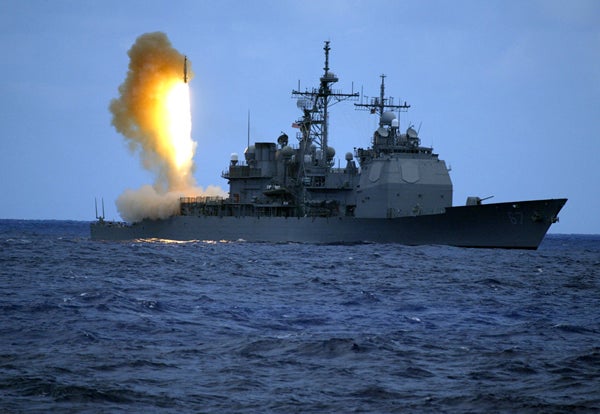Last week, the Aegis ballistic missile defense system successfully intercepted a complex separating short-range ballistic missile target. A rigorous testing program is essential for getting the U.S. ahead of the advancing ballistic missile threat.
The test exercised the second generation of the sea-based Aegis system. It is designed to intercept longer range and more sophisticated ballistic missiles.
The Daily Signal depends on the support of readers like you. Donate now
The ship, the USS Lake Erie, detected and tracked the incoming missile with its AN/SPY-1 radar. For the first time in the history of the SM-3 Block IB, two interceptors were launched against the incoming missile, further stressing the system and increasing operational realism.
The SM-3 Block IB intercepted its target at high altitude. That is important, because the higher the point at which the intercept occurs, the larger the defended area and the more flexibility for the commanders on the ground.
The U.S. should advance its missile defense capabilities to keep up with the ballistic missile threat.
Just earlier this year, North Korea threatened ballistic missile attacks on U.S. cities. It recently conducted its third nuclear device test and has been improving its ballistic missile program—an endeavor on which it cooperates with Iran. Ballistic missiles remain a weapon of choice for North Korea because of U.S. and allied vulnerability to these weapons and their extremely short delivery times.
North Korean threats and its advancing capability prompted the Obama Administration to reverse its course on certain elements of U.S. missile defense policy. In April, the President decided to increase the number of the Ground-Based Midcourse Defense interceptors to 44, which is the number that the Bush Administration originally planned to deploy in the U.S.
However, the President also effectively killed the SM-3 Block IIB interceptor, which would enhance U.S. protection from long-range missiles, and the missile defense program has been significantly underfunded on his watch.
If a U.S. adversary uses a nuclear-tipped long-range ballistic missile, it would take no more than 33 minutes for the missile to reach the U.S. The time lines are even shorter if an enemy launches a short-range ballistic missile. The U.S. currently has a limited protection against short-range ballistic missiles launched off the coast of the U.S.
This was the 27th successful intercept in 33 flight test attempts for the Aegis program since flight testing began in 2002. The test represents a step forward for the overall U.S. ballistic missile defense program.































